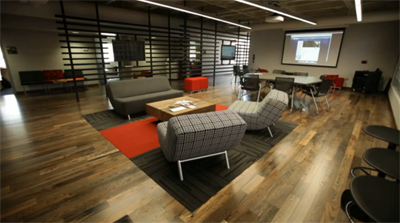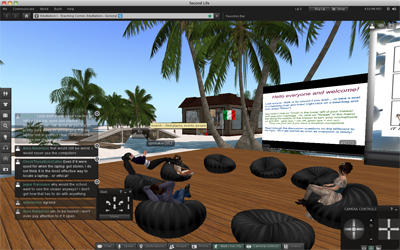Angel Pazurek is a one-take teacher.
Her class at the University of Minnesota is called Sex, Drugs and the Internet: Educational Perspectives. Pazurek records a weekly video message to her students with the built-in camera on her laptop. She lays out the work ahead and comments on class participation from the week before.
"When I create these videos, I always go with one take," Pazurek says. "If I mess up, I keep going. It's important to be authentic."
Pazurek's class is conducted entirely online. She requires her students to submit their own video and audio comments. They also post written remarks for class discussion blogs.
"Students are used to sharing via texts. It's not as intrusive," Pazurek says. "But when I ask them to share via audio or video, they are more hesitant. Often they comment on how awkward it feels. So I am transparent and share with them that I, too, get nervous before creating a video."
Angel Pazurek is a teaching specialist in the University of Minnesota's LT Media Lab in the College of Education and Human Development. LT stands for learning technologies. The lab experiments with a variety of ways to use digital technologies and new media to improve learning in elementary and secondary schools, as well as in college classrooms that meet face-to-face and online. Pazurek's class on the Internet is one of the courses taught using the lab's techniques for making online education more dynamic.
Facebook not Textbook
More than 6 million students now take at least one college course online, according to a study by the Babson Survey Research Group and the College Board. But Web-based learning started less than two decades ago. So if one can say there's an "old school" approach to online course design, it typically involves posting lengthy blocks of text for students to read, sometimes accompanied by illustrations, video lectures and links to YouTube. Class discussion typically takes place on a text-driven discussion board or in a similar chat room. The least inventive online courses have the look of a college textbook that's simply been pasted on the Web.
Courses designed by the LT Media Lab look more like Facebook pages than textbooks. The lab builds its courses using a social network platform called Ning. Most students post pictures of themselves. Many also share photos of their families, children and pets. The courses are password protected, so only those enrolled should have access. LT Media Lab co-director Aaron Doering says his team is creating not online classrooms, but "learning environments."
"It's much more than a classroom," Doering says. "Because in a classroom, students come in and they leave. In these online environments they're never leaving. I'm available most of the time and so are they. Together we're creating the kind of learning experience that many have not had before." The goal, Doering says, is for students to discover and create knowledge as a group, with the instructor acting as a guide through the assigned materials.
The title of Angel Pazurek's course -- Sex, Drugs and the Internet -- is meant to be both playful and provocative. The course focuses on children and their educational uses of the World Wide Web. Pazurek's students work through a series of readings and videos. They take a virtual field trip to the online simulation world called Second Life. Students also post video and podcast commentaries on what they're learning.
Online Advantages
Psychology major Annie Undis had taken online classes at a local community college before she transferred to the University of Minnesota. Her earlier online courses were made up mostly of readings and quizzes; there was little interactivity. She says Pazurek's class, with its social media design, was much more engaging. "This was the first online class that seemed like a real classroom. That was cool," Undis says. She logged into the course mostly from home and enjoyed the convenience of going to class at any hour. Undis shares a house in Minneapolis with an aunt and works as a personal care attendant to a disabled boy in Twin Cities suburb.
Undis says a course focusing on cultural use of the Internet naturally lent itself to being taught online. She's less certain that more advanced courses in her major field, psychology, would work as well on the Web. "You kind of feed off other people's perspectives in a face-to-face class," Undis says. "That's harder to convey with a posted video or text."
Political science major Jeong Gyun Kang found discussions in the online course often easier to follow than in his face-to-face classes. Kang is from South Korea and English is a second language for him. Sometimes he loses track of a classroom conversation when he doesn't fully understand what's being said. He often records class discussions on his iPod to review later. "In the online class I can always check my dictionary if I don't understand the meaning of a word," Kang says. He added that the Sex, Drugs and the Internet course was one of the best he's taken at the University.
Pazurek's course was among the last that child psychology major Erin Sipe took before graduating. She says she felt more comfortable speaking out in the virtual discussion groups than she would have face-to-face. "It's easier to think about what you're going to say and then write that down," Sipe says. "Everybody knows it's a safe environment to say what you think."
Pazurek says it's common for shy students who would huddle quietly in the back of a classroom to pipe up when they go online. "You can't stay in the back online," Pazurek says. "You have to log in and you have to share." But she says it can be easier in an online class to come off sounding strident or harsh, especially when communicating by text. Body language and tone of voice are critical communication cues that go missing online. Sometimes Pazurek has to pull a student aside, as it were, and gently suggest a different approach.
High Ratings and Reviews
Angel Pazurek's online classes fill up quickly -- sometimes within minutes of being opened for registration. She teaches two sections of the Internet class, each with 20 students. The classes are kept relatively small to allow Pazurek to give each student individual attention.
Aaron Doering says Pazurek is one of the most effective online teachers on the LT team. He says her upbeat weekly videos and the steady stream of written conversation she maintains with students set the mood for the course. "It comes down to building trust, having a social presence and showing students you actually care," Doering says. "Your students need to understand that you're not just on that screen, you're an individual."
Doering says conventional online classes typically draw lower evaluation marks from college students than face-to-face courses. However, he adds, dropout rates for classes taught by the LT Media Lab are lower than average, and evaluations are more positive than average. He's convinced that the social media approach is a key reason.







